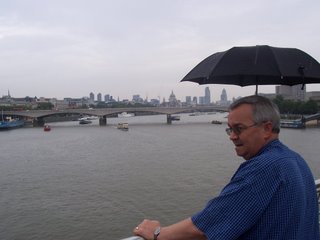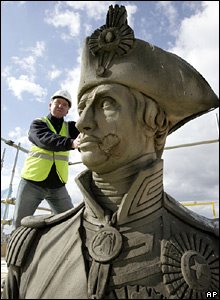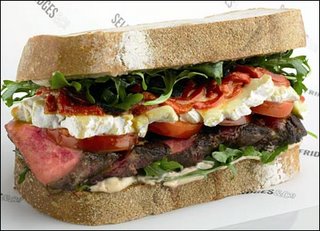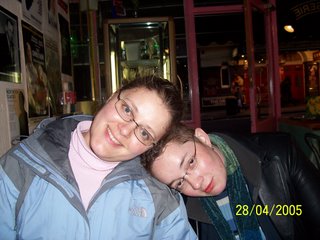Friday, April 28, 2006
Bank Holidays
Die UK het soortgelyke probleme gehad tot hulle Bank Holidays ingestel het. Dit val op Vrydae of Maandae. Problem solved ;-)
Hulle vakansiedae is op:
1 January
2 January
17 March
St Patrick's Day (also Republic of Ireland)
The Friday before Easter Sunday
Good Friday
The day after Easter Sunday
Easter Monday
First Monday in May¹
Last Monday in May²
First Monday In June
12 July
Battle of the Boyne - Orangemen's Day
First Monday in August
Last Monday in August
Summer Bank Holiday
Last Monday in October
25 December
Christmas Day
26 December or 27 December ³
Boxing Day (St Stephen's Day in the Republic of Ireland)
Dus... geen probleme met dae tussen vakansiedae en naweke nie, want hulle vakansiedae maak dit reeds lang naweke.
Die naam Bank Holiday
The term started out referring to days when banks (in the U.K.) were closed so that bank employees could have a holiday. Before 1834, banks observed 33 days a year as bank holidays, and these were mostly saints' days and the typical church holidays like Christmas and Easter. In 1834, however, bank workers had most of those taken away such that the only holidays left were Good Friday, May 1st, November 1st, and Christmas Day. Yet, someone felt for the poor bank workers, so that in 1871, Sir John Lubbock's Act was passed, naming the following as bank holidays in England and Ireland: Easter Monday, Whit Monday, the first Monday in August, and Boxing Day (December 26). In Scotland they got New Year's Day, May Day, the first Monday in August, and Christmas Day. These holidays came to be appropriated by non-bank workers, but the term had already stuck. So, no matter for whom one works, one gets bank holidays. (www.takeourword.com).
Wat maak Harry nou?
Wednesday, April 26, 2006
Swart sambrele...
So van skepe gepraat...
Hier is die storie...
Message at sea 'litter'
Napeague - A boat captain who sent a message out to sea in a bottle says he received a reply from Britain - accusing him of littering.
"I kind of felt like no good deed goes unpunished," Harvey Bennett, 55, told the East Hampton Star.
The plastic bottle was one of five that Bennett placed in the ocean off New York's Long Island in August.
Last week, he excitedly opened a letter from England, and was stunned by the reply:
"I recently found your bottle while taking a scenic walk on the beach by Poole Harbour. While you may consider this some profound experiment on the path and speed" of "oceanic currents, I have another name for it, litter".
"You Americans don't seem to be happy unless you are mucking about somewhere," says the letter, signed by Henry Biggelsworth of Bournemouth, in Dorset county.
Bennett, who has a picture of the queen of England in his tackle shop, says that Poole Harbour is just a short distance from the place from which his ancestors embarked for America in 1644.
The New York Post carried the report on Friday, giving attribution to the East Hampton Star.
Bennett did not immediately return a call from The Associated Press on Friday.
Tuesday, April 25, 2006
Cutty Sark
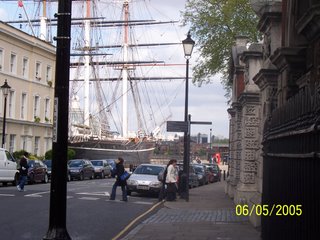
Die Cutty Sark was, in 1869, een van die laaste clippers wat gebou is en sy is die enigste klassieke clipper wat behoue gebly het. Sy lê nou in droogdokke in Greenwich (baie naby aan die National Maritime Museum en Greenwich tydlyn).
Die skip is vernoem na ‘n kort rompie wat beskryf word in die gedig Tam o' Shanter van Robert Burns. Sy is ontwerp deur Hercules Linton en in 1869 in Dumbarton, Skotland, gebou vir kaptein John Willis.
Die skip was bestem vir die Chinese teehandel, in daardie jare ‘n baie kompeterende resies om die aarde van China na London met reuse winste vir die skip met die eerste tee van die jaar. Sy het egter nie goed gevaar nie. In 1872 het sy en die Thermopylae saam uit Shanghai vertrek op 18 Junie, maar sy het haar roer verloor en eers ‘n week na die Thermopylae in London aangekom. Wat was so besonders aan die resies? Haar kaptein het met ‘n geimproviseerde roer aangegaan in plaas daarvan om in ‘n hawe vir ‘n nuwe een te wag en hulle is ten spyte hiervan met net ‘n week geklop!
Clippers is vervang deur stoomskepe in die teehandel en die Cutty Sark is toe gebruik vir die Australiaanse wolhandel. Sy kon van Australië tot in London vaar in net 67 dae. Sy was toe die vinnigste skip van haar grootte.
In 1895 het Willis haar aan die Portugese firma van Ferreira verkoop en sy is herdoop na die maatskappy. Sy was toe in Kaapstad gestasioneer. In 1922 het kaptein Wilfred Dowman haar gekoop en herstel tot haar oorspronklike voorkoms. In 1954 is sy droogdokke toe.
Die Cutty Sark word in Hart Crane se lang gedig "The Bridge" (gepubliseer in 1930) genoem.
Vandag is sy ‘n museumskip en prominente landmerk op die London marathon. Die publiek kan (teen ‘n fooi) aan boord gaan en rondkyk.
Die grootste toeriste-aantreklikheid... die huis van Windsor!
Ons bly 'n halfpad om die aarde van hulle af, maar hulle is nog elke dag in ons koerante. Die koningin se verjaarsdag, haar jubilee, Charles en Camilla, William, Diana, Andrew, Fergie en hulle kinders... en wie is die prins van die oomblik? Harry! Harry wil Irak toe gaan... hier is die nuutste storie van News 24 oor die rooikop.
Harry 'shielded' from war
Related articles
Harry determined to fight
Harry could fight in Iraq
Strip and stripes for Harry
London - Britain's Prince Harry, an army officer and third in line to the throne, may be shielded from the frontline if his unit is sent to war, the Ministry of Defence said on Monday.
Harry's deployment or continuing presence in a conflict zone might be brought into question if the prince, who graduated as an army officer this month, were to become a specific target, the ministry said.
There is a tradition of British royals serving in the armed forces. Harry's uncle, the Duke of York, flew a helicopter in the Falkland's War in 1982 and his great-grandfather King George VI saw action in World War One.
Harry, 21, who is in the infantry and is training to command 11 men and four light tanks in an armed reconnaissance unit, has insisted he wants a frontline role.
However, a ministry spokesperson said his role would have to be carefully monitored.
Dangers involved
"The intention is that Prince Harry will undertake the fullest range of deployments, both operational and training," a ministry spokesperson said.
"But on occasions there may be some circumstances where his overt presence might attract additional attention that could increase the potential risk to those he commands or himself," she said.
Harry, whose mother Princess Diana died in a Paris car crash when he was 12, is a Second Lieutenant in the Household Cavalry. The regiment is due to go to Iraq next year and British soldiers are also deployed in Afghanistan.
Harry, once dubbed a wild child for underage drink and drug antics, made it clear in an interview to mark his 21st birthday this year that he would not shy away from action and the ministry stressed that he joined to become an "operational soldier".
"There is no way I am going to put myself through Sandhurst (military academy) and then sit on my arse back home while my boys are out fighting for their country," he said.
Harry is the younger son of Prince Charles, the heir to the British throne.
Friday, April 21, 2006
Die London marathon
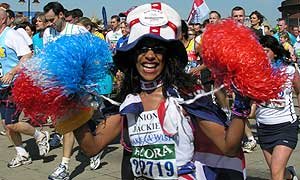
Sondag, op St George's Day, word die London marathon gehardloop.
Dit sal die 26ste marathon wees. Die marathon se webtuiste vertel die storie soos volg:
In 1979, hours after having run the New York Marathon, the former Olympic champion Chris Brasher wrote an article for The Observer which began: "To believe this story you must believe that the human race be one joyous family, working together, laughing together, achieving the impossible. Last Sunday, in one of the most trouble-stricken cities in the world, 11,532 men and women from 40 countries in the world, assisted by over a million black, white and yellow people, laughed, cheered and suffered during the greatest folk festival the world has seen." Enchanted with the sight of people coming together for such an occasion, he concluded questioning "..whether London could stage such a festival?"
Within months the London Marathon was born, with Brasher making trips to America to study the race organisation and finance of big city marathons such as New York and Boston, the oldest in the world. He secured a contract with Gillette of £50,000, established the organisation's charitable status, and set down six main aims for the event, which he not only hoped would echo the scenes he had witnessed in New York, but also put Britain firmly on the map as a country capable of organising major events.
His vision was realised on March 29th 1981, with the inaugural London Marathon proving an instant success. More than 20,000 people applied to run: 7,747 were accepted and 6,255 crossed the finish line on Constitution Hill as cheering crowds lined the route. Now at capacity, a total of 46,500 were accepted from a record 80,500 applicants, with 32,563 finishing on the day. Since this time the event has continued to grow in size, stature and popularity with a capacity 46,500 accepted entrants each year. In all, a total of 572,174 have completed the race since its inception with a record 32,899 crossing the line in 2002.
If anything, interest has been even greater for 2005 with a record 98,500 UK ballot applicants seeking places, a 20 percent increase over the previous highest figure.
Daar sal webcams wees wat dit afneem, jy kan daarna kyk by http://www.bbc.co.uk/london/content/articles/2006/04/20/marathon_webcams.shtml.
As jou vingers fikser as jy is, kan jy ook virtueel saamdraf by http://www.bbc.co.uk/london/sport/marathon/marathon_virtual_tour_feature.shtml. Die hele 26.2 myl is nou daar te sien!
En Pieter en Anca? Hardloop nie die marathon nie... erger, hulle trek!
Thursday, April 20, 2006
Die Union Jack
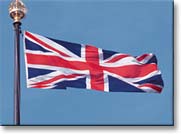
Ek het die foto en inligting van Monarchy Today af gekry.
The Union Flag, or Union Jack, is the national flag of the United Kingdom. It is so called because it combines the emblems of the three countries united under one Sovereign - the kingdoms of England and Wales, of Scotland and of Ireland (although since 1921 only Northern Ireland has been part of the United Kingdom).
The term Union Jack possibly dates from Queen Anne's time (reigned 1702-14), but its origin is uncertain. It may come from the 'jack-et' of the English or Scottish soldiers; or from the name of James I who originated the first union in 1603, in either its Latin or French form Jacobus or Jacques; or, as 'jack' once meant small, the name may be derived from a royal proclamation issued by Charles II that the Union Flag should be flown only by ships of the Royal Navy as a jack, a small flag at the bowsprit.
The flag consists of three heraldic crosses.The cross of St George, patron saint of England since the 1270's, is a red cross on a white ground. After James I succeeded to the throne, it was combined with the cross of St. Andrew in 1606. The cross saltire of St Andrew, patron saint of Scotland, is a diagonal white cross on a blue ground.
The cross saltire of St Patrick, patron saint of Ireland, is a diagonal red cross on a white ground. This was combined with the previous Union Flag of St George and St Andrew, after the Act of Union of Ireland with England (and Wales) and Scotland on 1 January 1801, to create the Union Flag that has been flown ever since.
The Welsh dragon does not appear on the Union Flag. This is because when the first Union Flag was created in 1606, the Principality of Wales by that time was already united with England and was no longer a separate principality.
The Union Flag was originally a Royal flag (when the present design was made official in 1801, it was ordered to be flown on all the King's forts and castles, but not elsewhere).
It is today flown above Buckingham Palace, Windsor Castle and Sandringham when The Queen is not in residence. The Royal Arms of Scotland (Lion Rampant) is flown at the Palace of Holyroodhouse and Balmoral when The Queen is not in residence. On news of a Royal death, the Union Flag (or the Royal Arms of Scotland (Lion Rampant) where appropriate) will be flown at half-mast. The Royal Standard is never flown at half mast, as the Sovereign never dies (the new Monarch immediately succeeds his or her predecessor).
The flying of the Union Flag on public buildings is decided by the Department for Culture, Media and Sport at The Queen's command. The Union Flag is flown on government buildings on days marking the birthdays of members of the Royal family, Commonwealth Day, Coronation Day, The Queen's official birthday, Remembrance Day and on the days of the State Opening and prorogation of Parliament; it is also flown on St David's Day (Wales), St George's Day (England), St Andrew's Day (Scotland), and St Patrick's Day (Northern Ireland).
Although the Union Flag originated as a Royal flag, it is now also flown by many people and organisations elsewhere in the United Kingdom by long established custom. Its use as an emblem has extended beyond the form of a flag and the Union Jack is frequently depicted on other objects.
The Union Flag has particular significance to the Armed Forces. Flags of contrasting colours have been used to show the position of commanders in the field and their armies from early times. The heavy defensive armour of medieval times made recognition symbols essential, and flags or colours were necessary as rallying points for the horse and foot soldiers. One example of the historic importance of colours as the focus of loyalty to the Crown (and to the regiment) is the annual Trooping the Colour ceremony at Horse Guards Parade on the Sovereign's official birthday, when The Queen as Colonel-in-Chief of each of the five regiments of Foot Guards takes the salute. As an emblem of 'Her Majesty's Service', the Union Flag is the flag of the Army, which unlike the Royal Navy and the Royal Air Force, does not have its own ensign.
The Union Flag as the King's/Queen's Colour was therefore carried into battle, along with their own Regimental Colours, by a number of Army regiments (artillery did not need them, as their rallying point was the right-hand gun; rifle regiments do not carry colours as their original role was as scouts, which required stealth and concealment).British Regimental Colours were carried into battle for the last time in January 1881, when the 58th Foot (now part of the Royal Anglia Regiment) took their Colours into action against the Boers in the Transvaal, South Africa. Today, Infantry battalions have two colours or flags: the Queen's Colour (a Union Flag with the title and number of the battalion at the centre surmounted by St Edward's Crown, with First and Second World War battle honours on both sides), and the Regimental Colour (featuring the regimental badge and battle honours awarded for campaigns other than the two World Wars). Nowadays, the Union Flag is also carried in smaller form on the sides of Army vehicles and worn on uniforms as a distinguishing national emblem.
In the Royal Navy, flags and ensigns assumed the same importance as standards and colours in the Army. Until 1864, fleets were organised into White, Red and Blue squadrons, but in that year Queen Victoria ordered that the White Ensign - the red cross of St George with the Union Flag in the top left-hand corner - should be carried by all ships of the Royal Navy. The Naval Reserves and the Mercantile Marine were to fly the Blue and Red Ensigns respectively. There are also Queen's Colours for the Royal Navy in each of the present-day naval commands, based on the White Ensign, which are carried on suitable ceremonial occasions by naval colour parties.
King's or Queen's Colours have also been presented to the other Services. Colours were presented to the Royal Marines (formed as the Admiral's Regiment in 1664) by the Duke of Clarence (the future William IV) in 1827; today there are Queen's and regimental colours for each Royal Marine Commando. In 1947, George VI approved the award of King's Colours to the Royal Air Force for carrying on ceremonial occasions; King's or Queen's Colours have subsequently been presented, amongst others, to the Royal Air Force in the United Kingdom in 1951 and the Royal Auxiliary Air Force in 1989.
UK slaps passport 'ban' on SA 19/04/2006 23:02 - (SA)
Men had 'fake' SA passports
High-level talks on passports
Passport problems for SA
Al-Qaeda getting SA passports
Mandy Rossouw, Beeld
London - The British government has not accepted any South Africans who want to enter Britain with temporary passports since Wednesday, said British immigration minister Tom McNulty on Wednesday.
McNulty said South Africans travelling to Britain on temporary passports would not be allowed into the country because of "concern about the efficiency of the process of issuing South African passports".
A period of grace will be given to South Africans who already have made travel arrangements.
They can travel to Britain until June 1 2006 and their temporary passports still will be accepted.
McNulty said that people with South African passports that had not been obtained through the right channels, were arrested regularly at airports.
The passports were found on people of different nationalities.
"It's our opinion that temporary passports do not sufficiently determine the identity and nationality or they do not comply with internationally accepted practice.
Visa regulations
"As a result, intelligence sources argue that these passports are easy targets for people of other nationalities who want to enter Britain illegally."
McNulty emphasised that South Africans were still welcome in Britain, but not without a full, valid passport.
According to the prevailing immigration rules, South Africans may come to Britain without a visa and stay for six months. But, they can't do any work while they are in Britain.
If South Africans want to work in Britain, they have to get a work permit or a working-holiday visa before leaving South Africa.
This is the first time a full moratorium has been placed on the acceptance of passports in this way, said a British home office spokesperson.
He said temporary South African passports were misused mainly by people from other African countries, specifically South Africa's neighbouring states such as Zimbabwe.
"It has come to light that specifically South African passports are regularly misused.
"A while ago, the department identified a problem with these passports and, when we began looking more closely at them, we realised the problem was much greater than we'd thought."
Other people with temporary passports also can enter Britain until June 1 if they have obtained a valid visa from the British consulate before beginning their trip.
SA home affairs 'not aware' of ban
South African home affairs spokesperson Cleo Mosana said the department was not aware of the new arrangement. "The British government has the right to decide what control measures are necessary in the interests of their safety. "But the department of home affairs sees, as a priority, the integrity of the documents it issues and works unceasingly to achieve this goal," she said.
Twins lunch with the Queen 20/04/2006 07:54 - (SA)
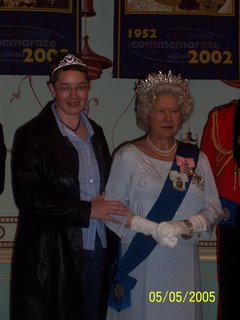
London - Queen Elizabeth invited 99 "twins" to Buckingham Palace on Wednesday for a slap-up lunch in the ballroom to mark the 80th birthday they all share.
The Queen, who turns 80 on Friday, was clearly moved by the by the celebrations, telling her guests "Thank you for coming today and I hope all those of you who are my exact twins will make the most of our special day on Friday."
"I doubt whether any of us would say the last 80 years have been plain sailing, but we can give thanks for our health and happiness, the support we receive from our families and friends, some wonderful memories and the excitement that each new day brings," she said.
The guests, who all share their birthdays on April 21 1926, were picked for the palace lunch by ballot in January.
Reflecting on lives that began in the year of the General Strike and saw World War Two as well as Britain's transformation into a prosperous modern society, she said "I believe we can and should count our blessings."
As three days of celebration began for the queen, Prime Minister Tony Blair led 80th birthday tributes in parliament, calling her one of the most "respected people of our time."
"Throughout, as part of the Royal Family and as the Queen, she has been a reassuring and unifying presence for her people," Blair told the House of Commons.
"Her Majesty shows no sign of slowing down. She has just undertaken what is her 14th tour of Australia, including the official opening of the Commonwealth Games in Melbourne, she attends literally hundreds of public engagements every year and is an active patron of over 600 charities and organisations."
Elizabeth has been on the throne for nearly 53 years and any suggestion that she might contemplate abdication was firmly squashed on Wednesday by her cousin who said she believed the monarch would never retire.
Margaret Rhodes said she did not believe abdication was an option.
"I'm perfectly certain she will never retire as such because it's not like a normal job," she told the BBC.
"It's a job for life and to the Queen the vows that she made on Coronation Day are something so deep and so special that she wouldn't consider not continuing to fulfil those vows until she dies," she added.
The Queen's actual birthday falls on Friday and she will mark the occasion with a walkabout outside Windsor Castle. Her eldest son and heir Prince Charles is hosting a private family dinner for her.
St George's Day - 23 April


St George's Day word op 23 April gevier in Engeland. Dit is baie kontroversieel en klaarblyklik weet 25% van die Engelse nie eens waaroor dit gaan nie.
Hierdie stukkie propaganda som eintlik die meeste daarvan op:
"Scotland has St Andrew,Wales has St David,Ireland has St Patrickand England has St George. But how many people wear a red rose on St George's Day?How many even know the date of St Georges Day or that he has been England's Patron Saint since the 14th century
when he was so designated by Edward III? Is it not surprising that England,
claiming to be a Christian country, pays so little heed to her patron saint? To the extent that a Suffolk landlord applyingfor an extension of licensing hours for the celebration of St Patrick's and St George's Dayswas granted the former but refused the latter!There are indeed dragons still to be slain, and perhaps the dragon of indifference is the hardest to overcome. So let the red rose of Englandtake its place with the Thistle, the Daffodil and the Shamrock."
Kortliks:
St George is is die heilige van Engeland. Hy het in 303 gesterf vir sy geloof en daar is baie mites oor hom. Hy sou onder andere 'n draak verslaan het.
Sy vlag (hierbo) is aangneem deur Richard the Lionheart en vorm deel van die Engelse vlag.
Hoe word St George's dag gevier? Dra 'n rooi roos (Engeland se nasionale blom) in jou knoopsgat! Maklik genoeg...
Wednesday, April 19, 2006
Marble Arch
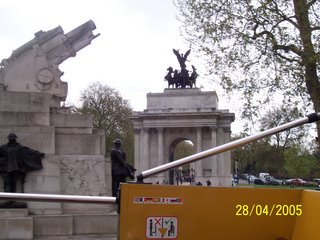 Marble Arch is ‘n wit Carrara marmer monument naby Speakers' Corner in Hyde Park.
Marble Arch is ‘n wit Carrara marmer monument naby Speakers' Corner in Hyde Park.Dis ontwerp deur John Nash in 1828, gebaseer op die sogenaamde triumphal arch van Konstantyn in Rome. Dit was oorspronklik bedoel as hek na Buckingham en is op die Pall Mall gebou. Dit was te nou vir die koets en is in 1851 verskuif na die huidige posisie.
Die drie kamertjies binne is gebruik as polisiestasie tot in 1950.
Net die koninklike familie en paleiswag mag daardeur gaan.
Tuesday, April 18, 2006
Lord Nelson word afgestof ;-)
Elvis leef nog (op die eiland)!
Daar is 'n horde teaters in London, meestal in die Wes Einde, maar ook in ander dele van die stad. Daar is 'n BAIE GROOT verskeidenheid van shows. Selfs die koning sing nog...
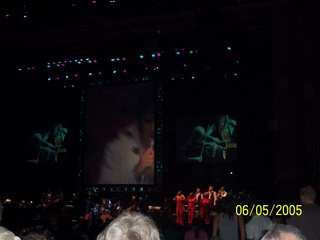
Wednesday, April 12, 2006
Pall Mall
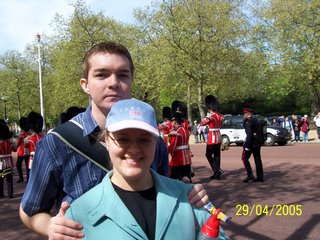
Pall Mall is ‘n straat in Westminster. Dit het bekend geword vir al die sogenaamde ‘gentemen’s clubs’ in die 19de eeu. Onder hulle was daar die Athenaeum, Travellers Club, Reform Club, United Services Club, Oxford & Cambridge Club and Royal Automobile Club.
Die straatnaam is afgelei van ‘n speletjie wat in die 17de eeu daar gespeel is.
Pall mall (uitgespreek pel mel) is ‘n balspeletjie.
Die straat is rooier as die ander strate in London. Hoekom? Want die koninklikes ry daarop tydens seremoniële parades…. ‘n lekker laaaaang rooi mat ;-)
Dis ook die roete waarlangs die wagte marsjeer wanneer hulle ruil.
Tuesday, April 11, 2006
Die Paleis van Westminster
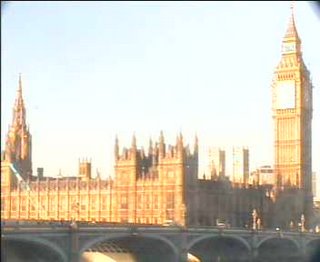
…is ook bekend as die Houses of Parliament. Dis waar die twee huise van die parlement (die House of Lords en die House of Commons) sit.
Die oudste deel van die paleis wat steeds bestaan, dateer uit 1097. Die paleis was oorspronklik ‘n koninklike woning, maar geen monarg het sedert die 16de eeu daarin gewoon nie. Die grootste deel van die struktuur dateer uit die 19de eeu toe die paleis herbou is nadat dit amper in 1834 in ‘n brand uitgewis is. Die argitekte was Sir Charles Barry en Augustus Welby Pugin. Big Ben is een van die torings in die paleis.
Die paleis was in die middeleeue strategies geplaas langs die Teemsrivier. Die tereein was in die middeleeue bekend as Thorney Island en was moontlik die woonplek van Canute die Grote wat van 1016 tot 1035 regeer het. Dit het later bekend geword as Westminster (West Monastery).
Daar is meer as 1 000 vertrekke in die paleis waarvan die belangrikste sekerlik die huise van die parlement is. Daar is ook raadsale, biblioteke, eetkamers, kroeë en gimnasiums. Die parlementêre kantore spil ook oor na nabygeleë geboue soos Portcullis House. Daar is meer as 100 stelle trappe en 5 kilometer se gange!
Die stene wat gebruik is vir die geboue was oorspronklik Anstone, ‘n sandkleurige steen wat in Anston in Yorkshire ontgin is. In 1910 was dit duidelik dat die stene vervang moes word en daar uiteindelik in 1928 besluit op Clipsham Stone, ‘n heuningkleurige leisteen uit Rutland. Die projek het in die 1930’s begin, maar is vertraag deur die tweede wêreldoorlog. Dis uiteindelik aan die begin van die 1950’s voltooi. Teen die 1960’s was daar weer probleme as gevolg van besoedeling. ‘n Steen-restorasie projek is van stapel gestuur in 1981 en in 1994 voltooi.
Daar is verskeie torings in die geboue. Die hoogste is die Victoria Toring (98 meter). Dis by die House of Lords se rekordkantoor (wat eintlik albei huise van die parlement se rekords het).
In die middel is Central Tower (91 meter). Die beroemdste van die torings is sekerlik Big Ben! Ek het ‘n hele Post daaroor geskryf, loer gerus ;-)
Daar is ‘n paar tuine op die terrein. Die Victoria Tower Gardens is ‘n publieke park langs die rivier, suid van die paleis. Daar is ook Black Rod's Garden (vernoem na die Gentleman Usher of the Black Rod), hierdie is ‘n private tuin. Die sogenaamde Old Palace Yard, voor die paleis, is nou geplavei. Cromwell Green en Speaker's Green is ook nie toeganklik vir die publiek nie.
Die House of Lords is in die suidelike deel van die paleis. Die vertrek is 14 by 24 meter groot en het rooi stoele. Daar is loodglas-vensters en 6 allegoriese fresco’s wat Godsdiens, ridderlikheid en die wet verteenwoordig. Die boonste deel of viewing gallery het ‘n gordyntjie om. Dis in die 1920’s gehang om die enkels en bene van vroue te bedek, want dit was onvanpas dat die here dit sou sien.
Aan die punt van die vertrek, is daar die troon waarop die koning/ koningin teoreties mag sit gedurende enige parlementsitting, maar hulle woon al jare lank net die opening van die parlement by. Ander lede van die koninklike familie wat die opening bywoon, sit op ‘chairs of state’ langs die troon. Voor die troon is die sogenaamde Woolsack, ‘n ruglose en armlose rooi kussing met wol gestop wat die historiese belang van wolhandel verteenwoordig.
Die House of Commons is aan die noordekant van die paleis. Dit is 14 by 21 meter groot. Hulle stoele is groen. Aan die een kant is die speaker se stoel, ‘n geskenk van Australië. Net 427 van die meer as 800 lede van die parlement kan geakkomodeer word.
Die laaste monarg wat in die House of Commons ingegaan het, was Koning Charles I (in 1642); hy het 5 lede op klag van hoogverraad gaan soek. Toe hy die Speaker, William Lenthall, gevra het waar hy die individue kan kry, het die geantwoord: "May it please your Majesty, I have neither eyes to see nor tongue to speak in this place but as the House is pleased to direct me, whose servant I am here."
Westminster Saal
Westminster Saal is die oudste deel in die paleis en is in 1097 opgerig. Histories het dit verskeie funksies gehad, maar is hoofsaaklik vir regspraak gebruik. Drie van die belagrikste howe is daar gehuisves: die Court of King's Bench, die Court of Common Pleas, en die Court of Chancery. In 1873 het die howe saamgesmelt om die High Court of Justice te vorm.
Van die twaalfde tot die negentiende eeu af is inhuldigingsplegtighede daar gehou. Die laaste banket van die aard is gehou vir Koning George IV (1821); sy opvolger, William IV, het gesê dat dit te duur was.
Staatsleiers het ook daar in staatsie gelê. Onder hulle was Sir Winston Churchill (1965) en onlangs HM Queen Elizabeth The Queen Mother in 2002.
Die United Nations Educational, Scientific and Cultural Organization (UNESCO) klassifiseer die Paleis van Westminster as ‘n World Heritage Site. Dis ook ‘n Graad I gelyste gebou.
Jy kan nie sommer net ingaan nie, maar daar is tog maniere:
Britte mag na die publieke debatte kyk van die gallery af. Hulle moet vooraf deur hulle MP kaartjies bekom.
Die Britte mag ‘n toer versoek van hulle MP’s wanneer die parlement in sitting is.
In die somer is daar toere vir Britte en toeriste, maar jy moet vooraf bespreek.
Die foto kom van die Live Webcam Site af.
Die National Maritime Museum
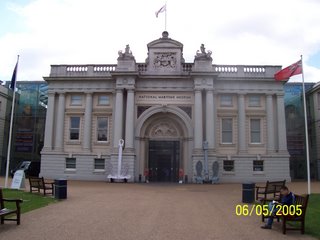
Die National Maritime Museum is by Greenwich en mag gratis besoek word. Ek het so bietjie meer daarvan vertel toe ek oor Greenwich geskryf het.
Die coolste ding in die museum? 'n Masjien waarmee jy golwe kan maak! Ek verstaan uiteindelik ook hoe dit werk ;-)
Hier is meer detail:
History of the National Maritime Museum
The National Maritime Museum (NMM) was formally established by Act of Parliament in 1934 and opened to the public by King George VI on 27 April 1937. It includes the 17th-century Queen's House and, from the 1950s, the Royal Observatory, Greenwich.
There is also a small museum at Cotehele Quay on the Tamar, Cornwall, with the NMM/National Trust sailing barge Shamrock, and the 'Valhalla' ships' figurehead collection on Tresco, Isles of Scilly.
The collections comprise about 2.48 million items, many on loan to museums elsewhere in Britain. The public galleries at Greenwich display a thematically arranged selection and the remainder are accessible for public interest and research in various ways. The majority of the NMM's small-boat collection is on display at the new National Maritime Museum, Cornwall, at Falmouth.
Find out more about the Museum's collections.
The Museum is funded by Government with additional income derived from trading activity and sponsorship. Entry to all Museum sites at Greenwich is free but charges are made for some special exhibitions. The Museum's objectives and targets are outlined in its current Funding Agreement.
Greenwich began to develop as a cultural visitor destination with Sir James Thornhill's completion of the Painted Hall (1707–26) in what is now the Old Royal Naval College (founded in 1694 as the Royal Hospital for Seamen). From 1823 a 'National Gallery of Naval Art', eventually including 300 portraits, paintings and artefacts, was created in the Hall, the first of its kind. A separate Naval Museum was also established in the Hospital buildings when it became the Royal Naval College - the 'Navy's university', 1873–1998.
After its foundation in 1910, the Society for Nautical Research (SNR) independently developed the aim of founding a 'national naval and nautical museum'. In 1927–28, following a public appeal organised by the Society, one of its wealthy members Sir James Caird (1864–1954) purchased the A.G.H. Macpherson Collection of maritime prints - over 11,000 items - with this in view. He also purchased the ship models from the training ship Mercury, with many other items being bought by him or otherwise donated.
All were vested in a temporary Trustee board, 1927–34, replaced by permanent NMM Trustees on passing of the 1934 Act. The contents of the Naval Museum in the College and other official material were also transferred to the care of the NMM Trustees under the 1934 Act, the Greenwich Hospital Collection from the Painted Hall being added by separate agreement in 1936.
The Museum's first Director from 1934 to his death was Professor (Sir) Geoffrey Callender (1875–1946), formerly Professor of History at the Royal Naval College, who was also both Secretary and Treasurer of the SNR and the main intellectual and organizational force behind the Museum's creation.
In 1933 the Royal Hospital School at Greenwich moved to Suffolk, vacating the Queen's House and related buildings which it had occupied since 1806, originally as the separate Royal Naval Asylum but combining with the 18th-century Greenwich Hospital School from 1821. The House was restored by the Ministry of Works and the flanking wings - added for the School between 1807–76, began a long period of museum conversion, largely at Sir James Caird's expense: this was only completed in 1951.
All the Museum buildings have subsequently been upgraded at various times and a full modern redevelopment of the main galleries, centring on what is now the Neptune Court, was completed 1999.
The Museum has the most important holdings in the world on the history of Britain at sea, including maritime art (both British and 17th-century Dutch), cartography, manuscripts including official public records, ship models and plans, scientific and navigational instruments, time-keeping and astronomy (based at the Observatory), and in many other categories.
You can see many items from the Museum's holdings on the Collections Online website. The Maritime Art Greenwich website is a searchable database of selected paintings plus in-depth content on some of the major themes of maritime art.
Its British portraits collection is only exceeded in size by the National Portrait Gallery and its holdings related to Nelson and Cook, among many other individuals, are unrivalled. It has the world's largest maritime historical reference library (100,000 volumes) including books dating back to the 15th century.
The Museum is also unique in the architectural importance of its main buildings, the Queen's House in particular being the keystone of the historic park-and-palace landscape of 'Maritime Greenwich’, which was inscribed as a UNESCO World Heritage Site in 1997.
Flamsteed House (1675–76), the original part of the Observatory, was designed by Sir Christopher Wren and was the first purpose-built scientific research facility in Britain. Take a virtual tour of Flamsteed House.
© NMM London
Thursday, April 06, 2006
Mrs Doubtfire is toe nie Amerikaans nie ;-)
LONDON, March 24 (UPI) -- A real-life "Mrs. Doubtfire" fooled a British couplefor five years into thinking he was a she and a suitable nanny for their kids.
But, time ran out for Erica (Edward) Sadowski, a veteran of the U.S. Air Force,when he disappeared with the children and was arrested after a former collegefriend spotted him.
The two little girls, 1 and 5 years old, were unharmed, the London Mirror said.Sadowski's double life was similar to the 1993 film in which Robin Williamsplayed a dad who posed as a nanny to see more of his kids.
Wednesday, April 05, 2006
Oxford Straat
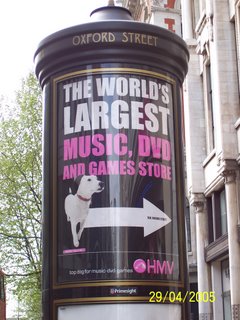
Oxford Street is ‘n groot ‘shopping’ straat in London. Dit strek van die Marble Arch en gaan deur Oxford Circus tot by St Giles' Circus.
Die straat volg die ou Romeinse roete wat Hampshire en Colchester verbind het. Tussen die 12de eeu en 1752 was dit bekend as Tyburn Street (die Tyburn rivier vloei onder die straat). Dit het berug geword as die roete waarmee gevangenes van Newgate Prison na die galg geneem is.
In die laat 18de eeu is baie van die omliggende grond deur die Earl van Oxford gekoop. Die moderne naam is aan hom te danke.
Van die groot winkels in die straat, sluit in:
Virgin Megastore,
Disney Store
Die Kersliggies in Oxford Straat is ‘n jaarlikse instelling en bekendes kom skakel dit gewoonlik aan. Die laaste paar jaar is die liggies aangeskakel deur…
2005 — Westlife
2004 — Steve Redgrave, Emma Watson
2003 — Enrique Iglesias
2002 — Blue
2001 — S Club 7
2000 — Charlotte Church
1999 — Ronan Keating
1998 — Zoe Ball
1997 — Peter Andre
1996 — Spice Girls
1995 — Coronation Street Cast
1994 — Lenny Henry
1993 — Richard Branson
1992 — Linford Christie
1991 — Westminster Children's Hospital
1990 — Cliff Richard
1989 — Gorden Kaye
1988 — Terry Wogan
1987 — Derek Jameson
1986 — Den and Angie Watts
1985 — Bob Geldof
1984 — Esther Rantzen
1983 — Pat Phoenix
1982 — Daley Thompson
1981 — Pilin Leon (Miss World, Venezuela)
Westminster Abbey
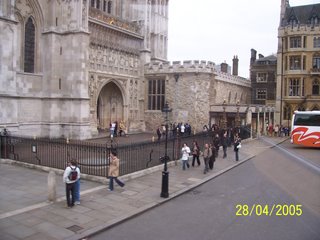
Die hoof van Westminster Abbey het hierdie geskiedenis geskryf en ek het nie gedink ek kan daarop verbeter nie ;-)
An architectural masterpiece of the 13th to 16th centuries, Westminster Abbey also presents a unique pageant of British history – the shrine of St Edward the Confessor, the tombs of kings and queens, and countless memorials to the famous and the great. It has been the setting for every Coronation since 1066 and for numerous other royal occasions. Today it is still a church dedicated to regular worship and to the celebration of great events in the life of the nation. Neither a cathedral nor a parish church, Westminster Abbey is a “Royal Peculiar” under the jurisdiction of a Dean and Chapter, subject only to the Sovereign.
Westminster Abbey, a work of architectural genius, a place of daily worship, deploying the resources of high musical expertise, a burial place of kings, statesmen, poets, scientists, warriors and musicians, is the result of a process of development across the centuries, which represents the response of a monastery and later a post-Reformation church to the stimulus and challenge of its environment.
In the 1040s King Edward (later St Edward the Confessor), last of the Anglo-Saxon kings, established his royal palace by the banks of the river Thames on land known as Thorney Island. Close by was a small Benedictine monastery founded under the patronage of King Edgar and St Dunstan around 960 AD. This monastery Edward chose to re-endow and greatly enlarge, building a large stone church in honour of St Peter the Apostle. This church became known as the “west minster” to distinguish it from St Paul’s Cathedral (the east minster) in the City of London. Unfortunately, when the new church was consecrated on 28 December 1065 the King was too ill to attend and died a few days later. His mortal remains were entombed in front of the High Altar.
The only traces of this Norman monastery are to be found in the round arches and massive supporting columns of the Undercroft in the Cloisters. This now houses the Abbey Museum but was originally part of the domestic quarters of the monks. Among the most significant ceremonies that occurred in the Norman Abbey were the coronation of William the Conqueror on Christmas day 1066, and the “translation” or moving of King Edward’s body to a new tomb a few years after his canonisation in 1161.
Edward’s Abbey survived for two centuries until the middle of the 13th century when King Henry III decided to rebuild it in the new Gothic style of architecture. It was a great age for cathedrals: in France it saw the construction of Amiens, Evreux and Chartres and in England Canterbury, Winchester and Salisbury, to mention a few. Under the decree of the King of England, Westminster Abbey was designed to be not only a great monastery and place of worship, but also a place for the coronation and burial of monarchs.
Every monarch since William the Conqueror, with the exception of Edward V and Edward VIII who were never crowned, has been crowned in the Abbey. It was natural that Henry III should wish to translate the body of the saintly Edward the Confessor into a more magnificent tomb behind the High Altar. This shrine survives and around it are buried a cluster of medieval kings and their consorts including Henry III, Edward I and Eleanor of Castile, Edward III and Philippa of Hainault, Richard II and Anne of Bohemia and Henry V. The Abbey contains some 600 monuments and wall tablets – the most important collection of monumental sculpture anywhere in the country - and over three thousand people are buried here. Notable among these is the Unknown Warrior, whose grave, close to the west door, has become a place of pilgrimage.
A remarkable new addition to the Abbey was the glorious Lady chapel built by King Henry VII, first of the Tudor monarchs, which now bears his name. The chapel has a spectacular fan-vaulted roof and the craftsmanship of Italian sculptor Torrigiano can be seen in Henry’s fine tomb. The banners of the Knights of the Order of the Bath, which surround the walls, together with the Battle of Britain window by Hugh Easton at the east end, give colour to this chapel.
Two centuries later a further addition was made to the Abbey when the western towers (left unfinished from medieval times) were completed, to a design by Nicholas Hawksmoor. Little remains of the original medieval stained glass, once one of the Abbey’s chief glories. The great west window and the rose window in the north transept date from the early 18th century but the remainder of the glass dates from the 19th century onwards.
History did not cease with the passing of the medieval monastery in 1540. Queen Elizabeth I, buried in one of the aisles of Henry VII’s chapel, refounded the Abbey in 1560 as a Collegiate Church, a Royal Peculiar exempt from the jurisdiction of bishops and with the Sovereign as its Visitor. In place of the monastic community a collegiate body of a dean and prebendaries, minor canons and a lay staff was established and charged with the task of continuing the tradition of daily worship (for which a musical foundation of choristers, singing men and organist was provided) and with the education of forty Scholars who formed the nucleus of what is now Westminster School (one of the country’s leading independent schools). In addition the Dean and Chapter were responsible for much of the civil government of Westminster, a role which was only fully relinquished in the early 20th century. Thus the Abbey was reshaped and newly patterned to discharge a distinctive yet worshipful role in a modern age.
Still today, a daily pattern of worship is offered to the Glory of God. Special services, representative of a wide spread of interest and social concern, are held regularly. In 1965-66 the Abbey celebrated its 900th anniversary, taking as its theme ‘One People’. Such a theme seemed to be fitting for a church which, through a long history of involvement with the developing life of the British people, has become known throughout the world.
©Dean and Chapter of Westminster 2005.
Tuesday, April 04, 2006
London Bridge
Die brug bestaan al byna 2 000 jaar op min of meer dieselfde plek. Die eerste brug op die plek is deur die Romeine met hout gebou in 46 nC.
Die brug is ‘n paar keer afgebrand of afgebreek om te verbeter.
William Wallace se kop is op die London Bridge vertoon na sy teregstelling. Na hom is ook die koppe van Jack Cade in 1450; Sir Thomas More in 1535; Biskop John Fisher, in 1535; en Thomas Cromwell in 1540 ook daar vertoon. ‘n Duitse besoeker het in 1598 30 koppe tegelyk daar getel.
In die 19de eeu moes die brug (toe al amper 600 jaar oud) weer vervang word. Die brug is vervang deur ‘n klassieke ontwerp van John Rennie.
Op 18 April 1968 is die brug aan die Amerikaanse entrepeneur Robert P. McCulloch vir $2,460,000 verkoop. Hy was klaarblyklik onder die indruk dat hy Tower Bridge gekoop het. Die brug is herbou in Lake Havasu City, Arizona.
Die huidige brug is gebou tussen 1967 en 1972 en op 17 Maart 1973 deur Koningin Elizabeth geopen.
Hung, drawn and quartered…
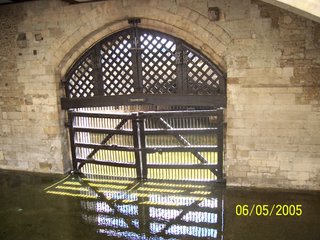
Verraad? In die ou Engeland sou jy twee keer gedink het! Die straf vir verraad (wat ernstiger as moord gesien is) was baie wreed. Mans is gehang, hulle ingewande uitgeryg en is dan opgesny. Vroue is tot in 1790 op brandstapels verbrand.
Dit het so gewerk…
…tot in 1870 is verraaiers:
Deur Traitors Gate in die Tower of London ingeneem (van die Teems af)
Gehang, maar afgehaal voor hulle dood is.
Hulle genitalië en ingewande is voor hulle oë uitgehaal en verbrand. Die hart is laaste verwyder en ook aan die skuldige gewys.
Hulle is onthoof en die liggaam is in vier dele opgesny.
Die koppe is op Tower Bridge vasgemaak waar die voëls dit gepik het… en die liggaamsdele? Na die uithoeke van die land gestuur!
Koning Edward I ('Longshanks') het die straf eerste gebruik. Die eerste slagoffer (in 1283) was die Walliese prins, Dafydd ap Gruffydd, en toe Sir William Wallace (van Braveheart – twee dekades later).
Monday, April 03, 2006
London Eye
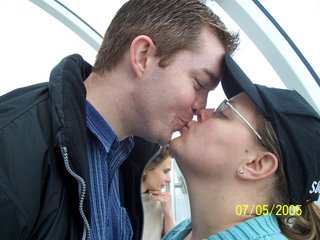
Die British Airways London Eye is ook bekend as die Millennium Wheel. Dis die eerste en grootste observasiewiel ooit.
Dis 135 meter hoog en neem ongeveer ‘n halfuur om ‘n vol sirkel te voltooi. Dis ontwerp deur die argitekte David Marks, Julia Barfield, Malcolm Cook, Mark Sparrowhawk, Steven Chilton, en Nic Bailey.

Daar is 32 passasierskapsules. Dit stop nie sodat mense in en uit kan klim nie, maar beweeg so stadig dat jy dit gemaklik in die ry kan doen.
Tony Blair het die Eye op 31 Desember 1999 geopen, maar dit was eers in Maart 2000 oop vir die publiek.
Die Eye is te sien (of te hoor ;-)) in ‘n paar films:
· Dit is (as subtiele grap) te hoor in A Knight's Tale wat in die middeleeue afspeel.
· Dis te sien in Bride and Prejudice (2004)
· Dis ‘n sentrale element in die 2005 reeks van Doctor Who.
· In 2005, was dit in The Amazing Race, waar spanne bakens moes soek met ‘n verkyker.
· In Thunderbirds, vlieg Thunderbird 2 deur London en land reg langs die Eye.
· In The Simpsons, ry Homer en Marge Simpson saam met hulle kinders daarin in The Regina Monologues episode.
April Fools Day
Die algemene teorie is dat dit ontstaan het uit die lighartigheid net na die somertyd begin en lente in die lug is!
Die heel eerste April Fools joke wat gedokumenteer is, kom inderdaad van die stiff upper lip Britte!
The very first April Fools Day joke that we have a written record of is the so-called washing of the lions at the tower of London. Supposedly visitors to London were told that there was going to be a washing of the lions at the tower and they were invited to attend this. Of course there are no lions at the tower of London so they would show up to see this and the joke would be on them, Ha, Ha April Fools. (Alex Boese)

